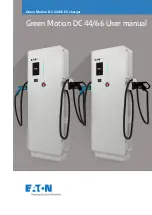
13
SENS IQ Technical Manual
Service hotline: 1.800.742.2326
1.303.678.7500
7
POWER ON/POWER OFF PROCEDURES
With the input AC and output DC breakers open, connect a portable voltmeter to the line side of the input AC
breaker on the charger. Energize the AC supply at main electrical panel and verify it is within acceptable range.
7.1
Verify Input AC Supply
With the input AC and output DC breakers open, connect a portable voltmeter to the load side of the DC
breaker and verify that the open circuit battery voltage is within acceptable range (see
TABLE 5
below).
See Section 8.2 to initially charge/commission zero charge batteries.
7.2
Verify Battery Voltage
Number of Cells
6
12
24
55
60
110
120
Nominal Charger
Output Voltage
12
24
48
110
120
220
240
Open Circuit
Voltage
12.0-12.9
24.0-25.8
48.0-51.6
110-118
120-129
220-237
240-258
Connect a portable voltmeter to the line side of the charger DC output circuit breaker. With the front panel
CHARGE MODE SELECT button, ensure the charger is in FLOAT mode (See Section 8.3). With the charger DC
output circuit breaker still open, close the charger AC input circuit breaker and verify that charger output comes up
to its nominal float setting. It should take less than 30 seconds for the charger output to reach its final value.
7.3
Verify Charger Output
7.4 Begin
Charging
Close the DC output breaker. Depending on the state of charge of the batteries and the load on the DC bus, the
charger may go into current limit at this time, in which case the output voltage as displayed on the LCD will be
reduced as the charger operates in constant current mode. Eventually as the battery is charged, the charging current
demand should taper to a value below the current limit set point of the charger, and the charger should revert to
constant voltage output, regulating the DC bus at the float level.
Table 5: Typical open circuit battery voltages for lead acid batteries
7.5 Power
Off
Power off the charger by opening the AC and DC breakers, in any order.
Table 4: Alarm contact designations
(Standard and Extended Alarm Relay Printed Circuit Boards)
6.4
Operating Chargers in Parallel
It is highly recommended that for proper operation of two chargers connected in parallel to the same battery that
one charger be equipped with a CommsGenius communications option and is connected to the second charger
with a digital load-sharing cable. See the CommsGenius User Manual available at www.sens-usa.com for more
information.
The digital load sharing cable should never be connected when two chargers are each connect-
ed to different batteries.
RELAY
CONTACTS
ALARM FUNCTION
SUMMARY
(on Control
PWA)
CHARGER
FAIL
AC FAIL
HIGH DC
GROUND
FAULT
BATTERY
CHECK
(Extended
Only)
LOW DC
BATTERY
END-OF-
DISCHARGE
(Extended Only)
COMMON
TB1-1
COM
TB4-1
COM
TB5-1
COM
TB6-1
COM
TB7-1
COM
TB8-1
COM
TB9-1
COM
TB10-1
COM
NORMALLY
CLOSED (NC)
OPEN ON
ALARM
TB1-3
OK
TB4-2
OK
Defaults to
OK with no
AC and DC
power
TB5-2
OK
TB6-2
OK
Defaults to
OK with no
AC and DC
power
TB7-2
OK
Defaults to
OK with no
AC and DC
power
TB8-2
OK
Defaults to
OK with no
AC and DC
power
TB9-2
OK
TB10-2
OK
NORMALLY
OPENED (NO)
CLOSE ON
ALARM
TB1-2
FAIL
Defaults to
FAIL with no
AC and DC
power
TB4-3
FAIL
TB5-3
FAIL
Defaults to
FAIL with no
AC and DC
power
TB6-3
FAIL
TB7-3
FAIL
TB8-3
FAIL
TB9-3
FAIL
Defaults to
FAIL with no
AC and DC
power
TB10-3
FAIL
Defaults to FAIL
with no AC and
DC power
For Normally Closed (NC) contacts wire from COM to OK. For Normally Open (NO) contacts wire from COM to FAIL.














































